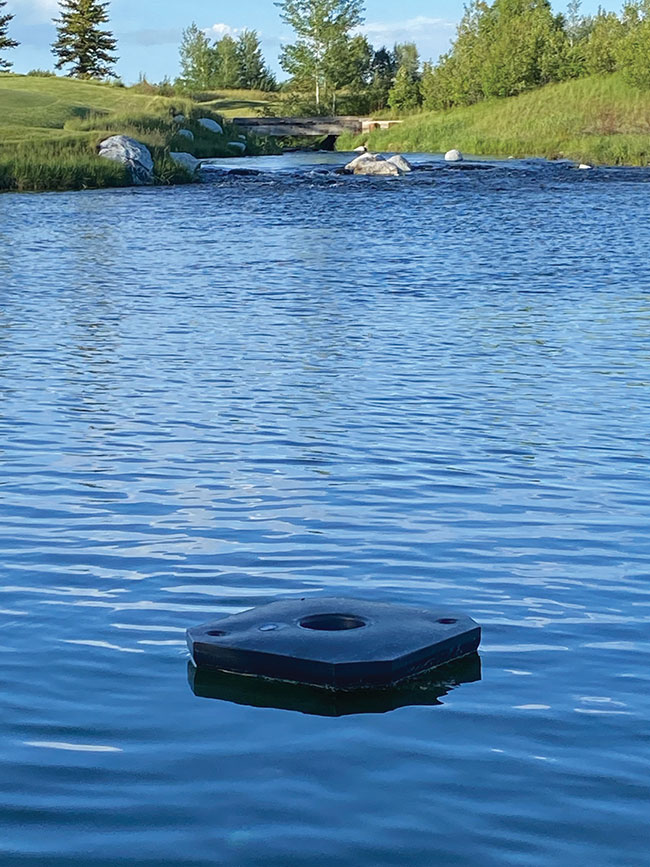
Features
Eco-Friendly Practices
Golf
Ultrasonic science works to prevent potentially dangerous blue-green algae blooms
Science targets vacuoles, leaving them dormant
August 9, 2022 By Mike Jiggens
 The WaterIQ product at work on a golf course pond. Photo credit: WaterIQ
The WaterIQ product at work on a golf course pond. Photo credit: WaterIQ Algae blooms in ponds and other smaller water bodies have reached almost epidemic proportions on many golf courses throughout Canada. When excess nitrogen and phosphorus in fertilizers are allowed to run off into water bodies, the heat of the season helps to form harmful algae blooms.
Unlike green algae, blue-green algae release a toxin that is harmful to both humans and wildlife. Traditionally, it is eradicated by chemical use – copper sulfate – but the algicide often goes beyond its intended target and kills beneficial bacteria in the water, creating a long-term detrimental effect.
“Algae blooms are becoming more of an issue for drinking water utilities for wastewater treatment plants, but also on golf courses, HOAs (homeowners associations) and agriculture settings where they’re using an irrigation pond filled with algae that hurts their crops,” Lawrence Field, CEO of Wyoming-based WaterIQ, says.
The company uses ultrasonic technology that targets algae’s gas vacuoles, making them dormant. Algae subsequently sinks to the bottom of a water feature where beneficial bacteria decomposes the organism within a day or two.
While playing a round of golf one day in Wyoming, Field witnessed first-hand the technology at work on a pond that was plagued with a serious algae problem. The golf course superintendent explained he couldn’t use chemicals to solve the problem due to the area’s environmental sensitivity.
Semi-retired at the time, Field purchased the company that distributed the product, already having had some
familiarity with ultrasonic technology. He previously used the science to detect anomalies in oil and gas pipelines during his earlier career as the operator of a large pipeline inspection business.
After having acquired the distribution company, he oversaw an upgrade of the product and its technology with the assistance of acoustical engineers, electrical engineers, chemical engineers and customer feedback. A prototype of the improved product was introduced last year during a conference for the wastewater treatment industry and was officially launched in February.
The environmentally friendlier alternative to algicides is an appliance that is placed in water and emits 2,056 ultrasonic frequencies every 36 minutes over a 360-degree radius. It sends power through a circuit board on the appliance’s piezo – its primary material – and the frequency acts in a scientific process called critical structural resonance.
Field compared the effect to that of an opera singer who, delivering the right pitch at the right decibel level, can cause crystal glass to vibrate and shatter.
The sound waves target only the algae but doesn’t result in an explosion of the organism.
For algae to thrive, it requires photosynthesis and must rise up and down in water every 24 hours. As algae sinks to the bottom, it decomposes, “and that’s the essence of what our technology does,” Field says. “It destroys these gas vacuoles inside the algae, and it sinks, and we’re seeing great success killing the blue-green and green algae without the use of chemicals.”
Golf course superintendents have become increasingly more ecologically conscious in recent decades and wish to avoid using chemical products whenever possible.
Canadian application
Le club de golf Memphremagog in Magog, Que. has embraced the ultrasonic technology for its ponds, and WaterIQ has already set up a dealership in the province.
Several North American golf courses have supplemented the technology with water aeration systems which help maintain water flow with dissolved oxygen and add aesthetic value to a water feature. Field says the aerators, or fountains, help with algae abatement, but noted aerators alone won’t kill algae.
“It helps keep the water moving, but it doesn’t eradicate the algae.”
WaterIQ is working with both golf superintendents and research departments at such institutions as Penn State and Cornell universities.
Although golf courses are an important part of the company’s targeted users, about 80 per cent of WaterIQ’s customers are drinking water utilities and wastewater treatment plants. Drinking water utilities often source water from lakes which frequently have algae issues.
Algae blooms have been increasing steadily around the world every year because of climate change, Field says, and it’s becoming an epidemic.
“It seems to be growing faster each year, and we’re seeing it occur earlier every year. The warmer the weather, the more we’re seeing outbreaks of algae.”
Field says California is seeing algae growth in February and March rather than April or May when it traditionally begins. Climate change hasn’t only resulted in warmer temperatures, it has led to extremes in weather. He says drought has triggered algae growth increases because recycled water is being used for irrigation and is applied to areas that already have algae in the water. Changes in salinity have also occurred because of climate change, and is contributing to the growth of algae, he adds.
As sea levels rise, ocean water is dumping algae into estuaries and subsequently reservoirs, which are impacted by runoff nitrogen and phosphorus in fertilizer.
Research is being conducted on the long-term disadvantages of using algicides to kill algae, and golf superintendents are heeding the data.
Field says ultrasonic technology used to eradicate algae in ponds requires comparatively less labour. Once the unit is installed in a pond, it is simply activated. Time-consuming chemical applications aren’t required.
WaterIQ is working with Troon Golf and has a system installed at the World Golf Village in St. Augustine, Fla. where testing showed high levels of blue-green algae.
Print this page